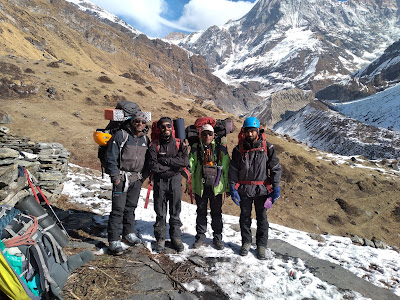During the 2nd and 3rd week of December 2020, a team of 4 climbers made an attempt to climb Mt Baljuri 5922m in Him-Alpine style by the Baljuri col-North ridge route. The expedition did not use the services of any HAP or local guide beyond the traditional base camp of Baljuri and adopted a fast and light ‘carry, camp and climb’ style. The team reached Dwali (2610m) on 12th December and used two alternate ferry days via Phurkia (3189m) to station themselves at the traditional Base Camp (3600m) site of Baljuri on 16th December. During the approach march, the team encountered fresh new snow from a kilometer below Dwali and half way up to the Zero Point (3750m) the team found the trail covered in 6 inches to 1 feet of snow.
On 17th December, 3 climbers (Aniket, Rivu and Anindya) started climbing the spur that leads one to the traditional Camp-1 site of Baljuri. The spur was a mixture of frozen grass, mud and boulders under a thick and deceptive blanket of soft new snow. The trio reached the traditional Camp-1 (4160m) area after 6 hours of climb. The camp 1 site (4160m) itself was comparatively free of snow as it faces East and gets a lot of early morning sun. On 18th December, the three started pushing higher and very soon they found themselves between knee-deep to waist-deep snow on a gradient that ranged between 35 to 45 degrees.
On 19th December, as the three started climbing further up, to their surprise they found no change or improvement in snow conditions as hoped due to overnight freezing. As the team was getting very close (100m) to reaching a comparatively easier angled Névé of the Buria glacier, they encountered slab formations big enough to sweep them off the face. It is then the team decided to turn back immediately. The team cleaned the Bivi site and started a long and slow descent to the valley floor. They reached the traditional Basecamp by 5pm that very day and over the next two days hiked back to the road head Kharakiya (2253m). Every protocol related to Covid-19 was maintained while the team traveled through cities, towns and villages en route.
Team: Aniket Mitra, Rivusoumya Das, Ashish Chanda and Anindya Mukherjee. Duration: 7th December, 2020 to 24th December, 2020.





Comments
Post a Comment